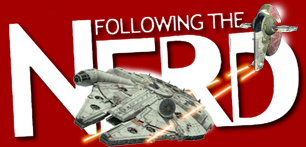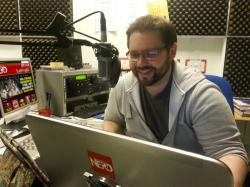The Hobbit Trilogy: Extended Blu-ray edition (12a)
Directed by: Peter Jackson
Starring: Martin Freeman, Ian McKellen & Richard Armitage
Running time(s): The Hobbit: An Unexpected Journey – 182 minutes/The Hobbit: The Desolation of Smaug – 186 minutes/The Hobbit: The Battle of the Five Armies – 174 minutes
Upon the news that we would be returning to Middle Earth for a movie adaptation of The Hobbit, none were more excited than me. The Lord of the Rings trilogy is a cinematic experience – yeah, I would use the word masterpiece – that, personally, has yet to be trumped on the big screen. The fans were on the fence though, upon this return; three films out of one short book? Seemed unnecessary, excessive and cash-grabby. Now that the smoke of dragon’s (and fanboy’s) fire has settled and the exquisite looking extended trilogy box set is here, across 15 Blu-ray discs, what kind of journey can one expect from the tale of Bilbo Baggins?
To fully critique the quest’s three instalments would have me sat here typing away well into next year; the rich extracts as well as the subtler tips-of-the-hat to Tolkien’s book are a delight, with audiences taking or leaving Jackson’s self-referencing nods to his LotR trilogy, most of which are very unsubtle indeed. But would these Hobbit films have completed the Middle Earth cinematic loop in the same way if another chap had been sitting in the director’s chair? Indeed, Jackson’s career and legacy will be based around the crowning achievement that were The Lord of the Rings. Has he made anything of such a standard since? Arguably not, but it’s not like we’re here to revel in another entry into the Lovely Bones saga.
Though one could use the nostalgia for LotR to observe The Hobbit trilogy with rose-tinted glasses from, it should not be the case. This is, after all, an entirely separate entity; or at least it should be treated as such, faults and all. And, as sad as it is to say, The Hobbit has some glaring flaws at times. Watching the grander moments, you realise that many of them take the book’s original smaller sense of scale and turn things all the way up to 11, washing away common sense in a tide of CGI. Though it’s clear that hard work and craftsmanship has gone into it in an attempt to help tell as big a story as possible, there are certainly times when we find ourselves in Uncanny Valley, removed from the experience because what we’re watching just doesn’t look right.
And I’m not even going to start talking about those bloody eagles. Someone needed to sit Jackson down a decade ago and say “Jeepers, Peter. Again with the eagles?”
But let’s not have this descend into a rant. There are still far too many positives outweighing the negatives. From Martin Freeman’s introduction in An Unexpected Journey, he IS Bilbo Baggins. Building on the foundation of Ian Holm, he is a believable, likeable, comical lead and a hobbit I would be quite happy to follow on any adventure. The first meeting of the dwarf ensemble takes its time, and quite rightly, giving us characters that we want to go on a journey with. The chemistry between Freeman and Ian McKellen’s Gandalf is superb, proudly carrying a lot of this first instalment. The unusual addition of the villainous white orc Azog aside (leading to some unnecessary action scenes that help pad out what could probably have been two movies into three), as well as the mishandling of the wizard Radagast the Brown’s character (literally crapped on from start to finish) and where there should be solid supporting characters we have a bit of a void at times. However, An Unexpected Journey gets our story rolling, a little shaky, but scenes like Bilbo’s life and death game of riddles in the dark with Gollum certainly outshine the bad.
The Desolation of Smaug (these films taught us that we’ve all been saying that name wrong for decades, apparently) seems like the tricky second album. Though we do get to see more of the world – and the involvement of the elves (Lee Pace is a glorious, frightening spectre of a figure as Thranduil) and the building blocks of Gandalf’s side quest around the mysterious Necromancer will leave smiles on the faces of LotR fans – sometimes these really do feel more like companion pieces for the diehards more than new movies for casual viewers. But to those who brave them, once you get your hands on the extended cuts, you really won’t want to go back; their more expansive character developments and plot restructuring feel firmer in this presentation. The Desolation of Smaug feels the most assisted by having an extended cut, as by the time Bilbo and the dwarfs have their epic face off with Smaug (boomingly voiced by Benedict Cumberbatch) you can rest easy that the conclusion of the story is a mere disc switch away, instead of that off-putting year’s wait we had in the cinema.
When you name your film The Battle of the Five Armies, it better do exactly what it says on the tin. And although you do wonder why this trilogy is indeed just that, when you fill your final film with the slaying of a dragon, the vanquishing of an evil spirit from beyond at the hands of your strongest magical entities as well as a raging grand scale battle, to be honest if you’ve made it this far you might as well enjoy the payoff of the epic battle stuff. With the extended edition’s conclusion wrapped up in a far less messy end (actually explaining what happened to the trilogy’s MacGuffin) when compared to the theatrical cut, these expanded versions are once again justified as the only way to truly experience these films, actually improving on the flaws many had of them in the first place.
“Hello, and welcome to Middle Earth” says Mr Jackson at the offset of the first bonus features appendices, accompanying An Unexpected Journey. If these extended cuts do these films justice, then the depths that the behind-the-scenes footage, video diaries, commentary tracks and interviews go to is the how to – and surprisingly more often than not how not to – bible of major motion picture movie making.
Now, some history. As it happens, the archiving of the trilogy’s production has left no stone unturned in regards to the warts-and-all production appendices; a feature-length extravaganza as vast as the movies themselves. An interesting tale develops across the six instalments; originally, Guillermo del Toro had been signed on to direct (oh what a different film that would have been), but the duty eventually fell on Jackson after setbacks caused del Toro to walk away from the project. Talks of delays, meltdowns and more delays on set, and the films were still just in pre-production at this point. A troubled shoot, to say the very least.
I couldn’t possible cut down this viewing experience to simple bullet points, but moments such as Ian McKellen’s on set breakdown, followed a few discs later with his comment “This is honestly the last one of these films,” on set, in full Gandalf garb, shows you the struggle this shoot was at times. To even hear Jackson say he spent a lot of time “not feeling on top of it” with this trilogy is a bold move, but it’s part of the story of telling the story that is important to hear. In fact, The Battle of the Five Armies appendices is perhaps the most interesting, getting to see the production’s biggest shortcomings.
That isn’t to say there aren’t lighter moments on the set. Though the scenes in Dol Guldur are bleak in the finished product, McKellen’s working relationship with Cate Blanchett keep things light behind the camera, and the gag that Gandalf’s mannequin double looks more than a little like Michael Gambon had me laughing for ages.
Just one of many stories to enjoy. With an absolutely gigantic cast and crew and production to study, fans of behind-the-scenes documentary films will fall in love with this boxset. It’s sentimental and pure nostalgia when they reflect upon the 15 year journey it has taken the team – so much of the same team over the six movies, a rare sight indeed – and rightfully so. These extras are the perfect accompaniment to their craft. The camaraderie between cast and crew, thanks to long-time friendships, working relationships and a little bit of fun and games is easy to watch, though it comes with a sombre feel when you hear from the late Christopher Lee, on the fact that he was just happy to have been a part of it all. It’s lovely to see the love he still had for the project, and how infectious that was.
Once again, these three extended cuts would have to be the preferred viewing experience of the fans. If you love this world, then you simply have to own these. The Blu-ray is a treat for the eyes, with the ridiculous amount of behind-the-scenes footage capable of keeping you busy for weeks. No, this is probably not the cut you would want to show a newcomer, but for the converted, this is a treasure worthy of questing to dungeons deep and caverns old for.
THE FILMS: 3.5 nerds
THE EXTRAS: 5 nerds





Nerd Comments